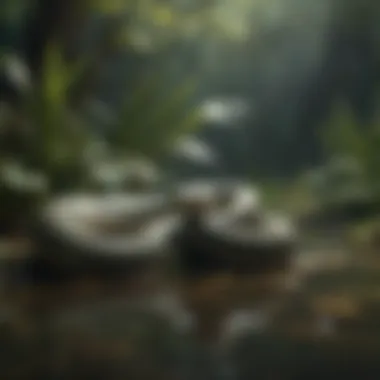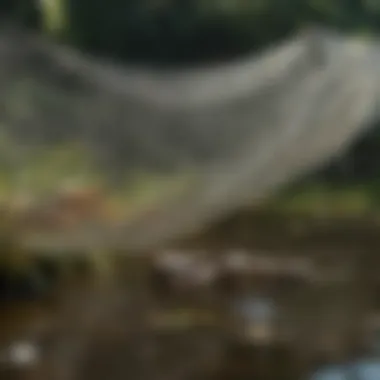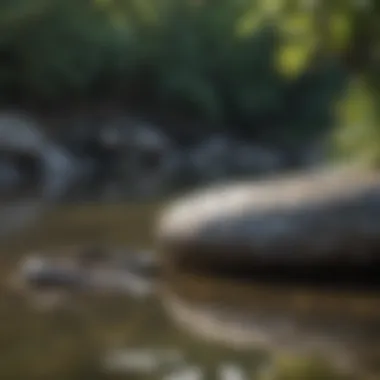Safeguard Your Pond: Proven Strategies to Keep Snakes Away


Animal Species Profile
Snakes are fascinating creatures that often evoke a sense of fear and intrigue. Their sleek bodies, distinctive scales, and mesmerizing movements make them truly captivating for animal enthusiasts. Snakes come in various species and sizes, with colors ranging from vibrant greens to earthy browns, each blending seamlessly with their natural surroundings. Their physical characteristics and appearance play a crucial role in their survival and behaviour.
Physical Characteristics and Appearance:
Snakes are commonly elongated reptiles that lack limbs, moving by slithering across diverse terrains with remarkable agility. Their scale patterns not only offer camouflage but also aid in thermoregulation. While some species boast iridescent scales that shimmer under sunlight, others have rough textures for better grip.
Natural Habitat and Distribution:
From lush jungles to arid deserts, snakes have adapted to thrive in diverse environments globally. They can be observed in tropical rainforests, arid grasslands, rocky crevices, and even suburban backyards. Understanding their natural habitat and distribution is essential in deterring snakes from encroaching on human environments.
Behavior and Social Interactions:
Snakes exhibit a spectrum of behaviours, from solitary to communal, based on their species. While some are nocturnal ambush predators, others are diurnal hunters. Understanding their behavioural patterns, such as mating rituals, hunting techniques, and social hierarchies, can aid in coexisting peacefully with these intriguing reptiles.


Understanding the Snake Threat
In this article, delving into the intricacies of the snake threat is cardinal in safeguarding your pond against unwanted intrusions. Understanding the behavior and characteristics of snakes commonly found near ponds is indispensable knowledge for anyone passionate about protecting their aquatic ecosystem. By grasping the habits and proclivities of these reptiles, you can efficiently implement effective countermeasures to deter them from your serene haven.
Types of Snakes commonly found near ponds
Types of snakes that are frequently sighted near ponds vary depending on the geographical location and prevalent ecosystem. Generally, water snakes such as the common water snake, garter snake, and sometimes even venomous species like the cottonmouth or water moccasin, may pose a risk to the tranquility of your pond. These snakes are adept swimmers and are attracted to water bodies for various reasons, from hunting prey to seeking refuge. Understanding the distinct characteristics of each type is crucial for devising targeted prevention strategies, ensuring a harmonious coexistence in your wildlife sanctuary.
Modifying the Pond Environment
When considering the topic of Modifying the Pond Environment in the realm of snake prevention, the significance cannot be overstated. Every aspect of the aquatic habitat plays a crucial role in deterring snakes from encroaching on the tranquil sanctuary of your pond. By implementing strategic landscaping measures, you not only enhance the aesthetic appeal of the surroundings but also create barriers that instinctually discourage snakes from infiltrating the area.
Landscaping techniques serve as a fundamental pillar in the defense against unwanted reptilian visitors. By strategically placing rocks, boulders, and plants strategically, you create physical obstacles that deter snakes from approaching the pond. Additionally, the use of dense shrubbery and tall grasses provides cover for prey, thus minimizing the attraction of snakes to the vicinity. These landscape modifications not only serve as visually appealing enhancements but also strategically disrupt the habitat favored by snakes, effectively safeguarding your pond.
Moreover, when modifying the pond environment, consideration must be given to incorporating features that support the native wildlife while deterring snakes. Introducing beneficial predators like bullfrogs or creating shelters for amphibians can establish a natural balance that discourages snake presence. Furthermore, proper maintenance of landscaping elements is essential to ensure their efficacy in snake prevention. Regular pruning, weeding, and monitoring are indispensable practices to uphold the integrity of the modified environment and sustain its protective capabilities.


Landscaping Techniques to Deter Snakes
In the quest to deter snakes through landscaping techniques, various strategies can be employed to fortify the pond environment against potential intruders. The strategic positioning of dense vegetation such as pampas grass or junipers acts as a natural deterrent, creating barriers that impede snake movement and nesting. Furthermore, incorporating mulch beds and rock formations around the pond periphery not only enhances the visual appeal but also serves as physical obstacles that dissuade snakes from venturing close.
Additionally, mindful selection of plant species resistant to pest insects attracts beneficial predators that naturally prey on snake food sources, contributing to a holistic approach in snake prevention. By creating a harmonious ecosystem within the pond surroundings, you not only harness the beauty of nature but also establish a self-sustaining environment that minimizes the risk of snake intrusion. Embracing landscaping techniques tailored for deterring snakes transcends mere aesthetic enhancements to encapsulate a strategic and eco-conscious defense mechanism for protecting your pond sanctuary.
Implementing Effective Physical Barriers
In the realm of pond management, the implementation of physical barriers plays a pivotal role in ensuring the exclusion of snakes from the premises. By scrutinizing various elements related to physical barriers, such as fencing systems, netting, and mesh installations, one can discern their significance in defending against unwanted serpentine intruders.
Fencing Options for Snake Prevention
When contemplating measures for snake prevention, the selection of appropriate fencing options emerges as a crucial consideration. Robust fencing acts as an impregnable shield, deterring snakes from infiltrating the pond environment. From chain-link to wire mesh fences, each variant presents unique advantages concerning durability, visibility, and ease of installation. Understanding the specific merits of distinct fencing types enables pond owners to make informed decisions tailored to their requirements.
Netting and Mesh Installations


Adding another layer of fortification, netting and mesh installations serve as supplementary means to bolster the pond's defenses against serpentine invasion. Fine mesh materials act as effective barriers, preventing snakes from gaining access while maintaining an aesthetic appeal to the surroundings. Intertwining the dynamics of mesh size, material strength, and installation techniques ensures comprehensive protection, instilling peace of mind for pond enthusiasts. By strategically deploying netting across vulnerable areas, pond proprietors elevate the security levels of their aquatic haven, fostering a tranquil coexistence with nature.
Utilizing Natural Repellents
When considering strategies to protect your pond from unwelcome serpent visitors, utilizing natural repellents emerges as a crucial aspect of defense. Natural repellents offer a non-toxic and environmentally friendly approach to deterring snakes, aligning with the ethos of many nature-loving pond owners. By exploring the realm of natural repellents, you delve into a domain rich with plant-based solutions that can help fortify your pond's boundaries.
Plant-based repellents for snake deterrence
Within the realm of natural repellents lie plant-based solutions that hold promise in deterring snakes from encroaching on your pond's peaceful habitat. Plants such as marigolds, lemongrass, and garlic emit odors that repel snakes, serving as a sustainable and aromatic shield against potential slithery invaders. Additionally, certain plants like wormwood and rue possess properties that snakes find aversive, further fortifying your pond's defenses.
Delving deeper into plant-based repellents unveils a world of botanical diversity that can be strategically leveraged to enhance your pond's snake protection measures. From cultivating snake-repelling plants around the perimeter of your pond to incorporating their extracts into sprays or solutions, the possibilities for integrating plant-based repellents into your defense strategy are vast and varied. By harnessing the power of nature's own defenses, you empower yourself to safeguard your aquatic haven effectively, fostering a harmonious coexistence between your pond and its surrounding ecosystem.
Maintaining a Snake-Free Pond
In the realm of pond maintenance, ensuring a snake-free environment stands as a paramount objective for animal enthusiasts and wildlife lovers. The vitality of maintaining a snake-free pond cannot be overstated as snakes pose a potential risk to the ecosystem balance and the safety of other pond inhabitants. By implementing rigorous practices to deter snakes from inhabiting the pond, individuals can cultivate a harmonious and secure aquatic space for all organisms involved.
Regular maintenance practices
Central to upholding a snake-free pond is the consistent application of regular maintenance practices. These practices encompass a myriad of duties, such as routine debris removal, water quality assessments, and vegetation upkeep. By diligently removing fallen leaves, twigs, and any organic matter that snakes may find appealing, pond owners can effectively mitigate the attractiveness of the environment to these reptiles. Furthermore, conducting regular water tests to ensure optimal conditions for aquatic life can aid in deterring snakes, as they are less likely to inhabit a well-maintained pond. Regular trimming of aquatic vegetation also plays a crucial role in minimizing potential hiding spots for snakes, promoting a more open and less snake-friendly habitat.
Monitoring for early signs of snake presence
Vigilant monitoring for early indications of snake presence is key to preemptively addressing any potential threats to the pond ecosystem. By closely observing the surroundings and being attentive to any disruptions in the pond environment, such as unusual movements or unexplained disappearance of small animals, pond keepers can proactively identify and address snake intrusions. Implementing strategically placed cameras or motion sensors can aid in monitoring nocturnal snake activities, providing valuable insights into the presence of these elusive creatures. Additionally, conducting regular perimeter checks and inspecting potential entry points for snakes can enhance the overall security measures of the pond, enabling prompt responses to any signs of snake activity.







